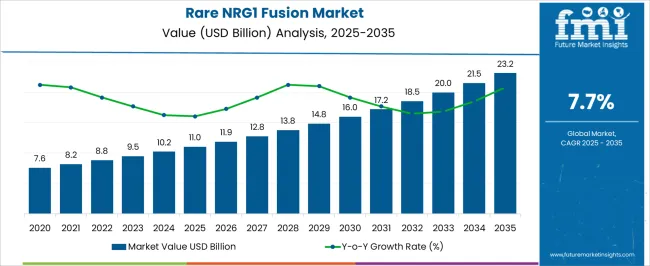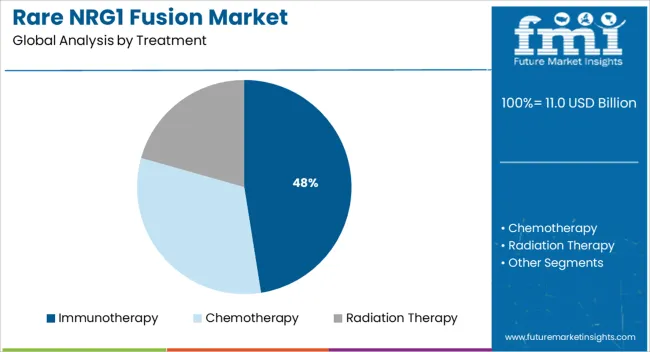The Rare NRG1 Fusion Market is estimated to be valued at USD 11.0 billion in 2025 and is projected to reach USD 23.2 billion by 2035, registering a compound annual growth rate (CAGR) of 7.7% over the forecast period.

| Metric | Value |
|---|---|
| Rare NRG1 Fusion Market Estimated Value in (2025 E) | USD 11.0 billion |
| Rare NRG1 Fusion Market Forecast Value in (2035 F) | USD 23.2 billion |
| Forecast CAGR (2025 to 2035) | 7.7% |
The rare NRG1 fusion market is undergoing notable evolution as advancements in molecular diagnostics and targeted therapies reshape treatment paradigms. Growing awareness of gene fusions in oncogenic pathways and the introduction of precision medicine have significantly expanded the potential patient pool for novel treatments.
Immunotherapy has emerged as a transformative option, supported by clinical evidence indicating superior outcomes in specific cohorts. Continued investments in genomiC testing infrastructure and heightened clinical trial activity are expected to accelerate innovation and broaden accessibility.
Regulatory support for orphan drug development and increasing collaborations between biopharma and diagnostic companies are paving the way for more personalized treatment options. Future growth opportunities are anticipated to arise from enhanced biomarker-driven patient selection, improved combination regimens, and further integration of next generation sequencing in routine clinical practice.
The market is segmented by Treatment and region. By Treatment, the market is divided into Immunotherapy, Chemotherapy, and Radiation Therapy. Regionally, the market is classified into North America, Latin America, Western Europe, Eastern Europe, Balkan & Baltic Countries, Russia & Belarus, Central Asia, East Asia, South Asia & Pacific, and the Middle East & Africa.

When segmented by treatment, immunotherapy is expected to account for 47.5 % of the rare NRG1 fusion market revenue in 2025, establishing itself as the leading treatment segment. This leadership is attributed to its ability to elicit durable responses by leveraging the body’s immune system to target tumors harboring NRG1 fusions.
Advances in immune checkpoint inhibitors and personalized neoantigen vaccines have improved clinical outcomes in patients who were previously refractory to conventional therapies. The segment’s growth has been reinforced by robust clinical pipelines, expanded regulatory approvals, and growing physician confidence in managing immune related adverse events.
Moreover, ongoing trials exploring synergistic effects of immunotherapy with targeted agents and chemotherapies have strengthened its adoption in both first line and subsequent lines of treatment. The convergence of scientific innovation, favorable safety profiles, and increasing inclusion in treatment guidelines has cemented immunotherapy as the preferred modality within this market.
The Rare NRG1 fusion market was valued at USD 7.6 Billion in 23.218 while growing at a CAGR of 7.6.7.61%. Technological advancements in the diagnosis and treatment of various cancers have opened up new prospects for the Rare NRG1 Fusion market which are augmenting market growth.
Further, Standard diagnostic procedures are aiding in market expansion. Considering these new advancements in Oncology, the market for Rare NRG1 Fusion is set to achieve a valuation of USD 23.2 billion with a CAGR of 7.73% by the end of 23.233.
Standard diagnostic protocols to fuel the market expansion
The dynamics of the Rare NRG1 Fusion Market are anticipated to revolutionize in the coming decade owing to the occurrence of such fusions in approximately 0.2% of solid tumors and other invasive tumors. Rare NRG1 Fusion is nothing short of a potential agent for a tumor-agnostic development approach.
Further, the Rare NRG1 Fusion Market is still in its innate state with only a handful of pharmaceutical companies operating in the domain, laying forward immense opportunities for other pharma companies to exploit which will augment the market growth.
Also, standard diagnostic protocols are anticipated to act as a major driver in the steady, smooth growth of the Rare NRG1 Fusion Market size. Additionally, a Rise in the number of research projects for the development of innovative tools and solutions that encourage early detection of tumour-causing mutations is expected to influence substantial growth of the Rare NRG1 Fusion market over the forecast period.
Difficulty in conducting clinical trials is holding back growth
The rarity of fusions undoubtedly in itself is a challenge that makes it difficult for researchers to study and conduct clinical trials, and the diversity of NRG1 fusions makes it difficult to diagnose or detect. These concerns are creating challenges for the market expansion of Rare NRG1 Fusion.
The surge in the use of rebuilt diagnostic imaging restricts the market growth
Due to high costs and budgetary constraints, many hospitals in developing nations are not able to invest in diagnostic imaging procedures. However, due to the high demand for diagnostic imaging procedures in these countries, the hospitals that cannot afford to purchase new and advanced imaging systems, prefer to use rebuilt imaging systems. Thus, this factor is a huge challenge for the Rare NRG1 Fusion market growth during the forecast period.
Europe is the fastest-growing region in the Rare NRG1 Fusion market. The increasing incidence of cancer cases in Europe clearly demands early detection and diagnosis of cancer. Researchers are consistently working to discover novel cancer diagnosis methods with minimal invasion. There are approximately 375000 cases of cancers detected each year, with a mortality rate of over 44.1%.
On the other hand, the increasing current health expenditure per capita in the European Union, which according to the World Bank, reached USD 3476.43 (in current USD) in the year 2020, up from USD 2636.35 in the year 2006, is projected to aid in the growth of Europe RARE NRG1 FUSION market. Besides this, the growing GDP per capita in the European Union is also anticipated to display significant growth opportunities for the Europe RARE NRG1 FUSION market during the forecast period.
The Japan Rare NRG1 Fusion Market is predicted to witness substantial expansion during the forecast period, i.e., 2025 to 2035. The growth of the market can majorly be attributed to the growing geriatric population (aged 65 years or over) in the nation. This growing geriatric population would be in need of advanced healthcare services, which is anticipated to drive the growth of the market in the coming years.
On the other hand, the Japan Rare NRG1 Fusion Market is also poised to grow on account of the numerous opportunities generated by the rising healthcare expenditure by the government of the nation.
Radiation therapy is the most widely used intervention in the Rare NRG1 Fusion market with a segment share of 45%. This segment is expected to grow at a high pace compared to immunotherapy and chemotherapy owing to its high effectiveness and use in primary stages of cancer in killing cancer cells.
Key players in the Rare NRG1 Fusion Market are Elevation Oncology, Merus, Hummingbird Bioscience, Boehringer Ingelheim, CANbridge Pharmaceuticals, Salubris Biotherapeutics, AVEO Oncology, Rain Therapeutics, Eli Lilly and Company, Jiangsu Hengrui Medicine.
Some recent developments in the market are:
| Report Attribute | Details |
|---|---|
| Market Value in 2025 | USD 11.0 billion |
| Market Value in 2035 | USD 23.2 billion |
| Growth Rate | CAGR of 7.73% from 2025 to 2035 |
| Base Year for Estimation | 2025 |
| Historical Data | 2020 to 2025 |
| Forecast Period | 2025 to 2035 |
| Quantitative Units | Revenue in USD Billion and CAGR from 2025 to 2035 |
| Report Coverage | Revenue Forecast, Volume Forecast, Company Ranking, Competitive Landscape, Growth Factors, Trends, and Pricing Analysis |
| Segments Covered | Treatment, Region |
| Regions Covered | North America; Latin America; Europe; Asia Pacific; Middle East & Africa |
| Key Countries Profiled | USA, Canada, Brazil, Mexico, Mexico, Germany, UK, France, Spain, Italy, Russia, China, Japan, South Korea, India, Australia, South Africa, Saudi Arabia, UAE, Israel |
| Key Companies Profiled | Elevation Oncology; Merus; Hummingbird Bioscience; Boehringer Ingelheim; CANbridge Pharmaceuticals; Salubris Biotherapeutics; AVEO Oncology; Rain Therapeutics; Eli Lilly and Company; Jiangsu Hengrui Medicine |
| Customization | Available Upon Request |
The global rare nrg1 fusion market is estimated to be valued at USD 11.0 billion in 2025.
The market size for the rare nrg1 fusion market is projected to reach USD 23.2 billion by 2035.
The rare nrg1 fusion market is expected to grow at a 7.7% CAGR between 2025 and 2035.
The key product types in rare nrg1 fusion market are immunotherapy, chemotherapy and radiation therapy.
In terms of , segment to command 0.0% share in the rare nrg1 fusion market in 2025.






Full Research Suite comprises of:
Market outlook & trends analysis
Interviews & case studies
Strategic recommendations
Vendor profiles & capabilities analysis
5-year forecasts
8 regions and 60+ country-level data splits
Market segment data splits
12 months of continuous data updates
DELIVERED AS:
PDF EXCEL ONLINE
Rare-earth Barium Copper Oxide (REBCO) Wire Market Size and Share Forecast Outlook 2025 to 2035
Rare Gas Market Size and Share Forecast Outlook 2025 to 2035
Rare Disease Clinical Trials Market Size and Share Forecast Outlook 2025 to 2035
Rare Sugar Market Size and Share Forecast Outlook 2025 to 2035
Rare Neurological Disease Treatment Market Report – Demand, Growth & Industry Outlook 2025-2035
Rare Inflammatory Disease Treatment Market Size and Share Forecast Outlook 2025 to 2035
Rare Gastrointestinal Diseases Treatment Market Trends and Forecast 2025 to 2035
Competitive Overview of Rare Earth Elements Companies
Industry Share Analysis for Rare Neurological Disease Treatment Providers
Rare Earth Metals Market Demand & Trends 2024-2034
Rare Disease Gene Therapy Market
Infrared Heating Pad Market Size and Share Forecast Outlook 2025 to 2035
Infrared Thermography Market Size and Share Forecast Outlook 2025 to 2035
Infrared Thermometer Market Growth – Trends & Forecast 2025 to 2035
Infrared Search and Track (IRST) Systems Market Analysis - Growth & Forecast 2025 to 2035
Infrared Sensors Market Analysis – Growth & Trends 2025 to 2035
Infrared (IR) LEDs Market by Component by Application & Region Forecast till 2035
Infrared Imaging Market
Mid-infrared Lasers Market Analysis - Growth & Trends 2025 to 2035
Near Infrared Absorbing Material Market Growth – Trends & Forecast 2024-2034

Thank you!
You will receive an email from our Business Development Manager. Please be sure to check your SPAM/JUNK folder too.
Chat With
MaRIA